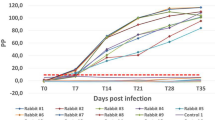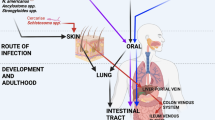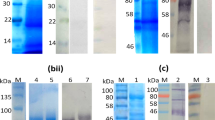Abstract
High levels of immunoglobulin E (IgE) are produced in animals, including man, infected with helminth parasites1,2. Such infection results not only in the production of parasite-specific IgE but also, through polyclonal stimulation of IgE-B cells, in the production of a large excess of parasitic nonspecific IgE3. IgE antibodies mediate allergic reactions by binding to receptors on the plasma membrane of mast cells, which are then said to be sensitised; subsequent attachment of antigen to the membrane-bound antibody causes cross-linking of the receptors leading to the release of histamine and other active substances4. Mast cells can be passively sensitised both in vivo and in vitro and passive sensitisation with a specific IgE antibody may be inhibited by prior saturation of IgE receptors with an excess of ‘nonspecific’ IgE5,6. In this way, helminth-infected animals become refractory to passive sensitisation, as do animals bearing IgE myelomas, because of the pre-emption of mast-cell receptors by endogenous IgE7,8. These findings gave rise to two related ideas: first, that it might be possible to ameliorate allergic diseases by passively administering, or by actively stimulating the production of a large amount of ‘irrelevant’ IgE; and second, that a high parasite-induced IgE level might protect against unrelated allergies by means of competition for mast cell receptors6,7,9. However, searches for epidemiological evidence of such a protective effect have had conflicting results10–21. We have examined this question using egg-albumin (E A)-hypersensitive rats infected with Nippostrongylus brasiliensis and now show that ‘nonspecific’ IgE induced by helminth infection, although having the capacity to block passive sensitisation, does not inhibit hypersensitivity reactions mediated by an actively produced IgE antibody.
This is a preview of subscription content, access via your institution
Access options
Subscribe to this journal
Receive 51 print issues and online access
$199.00 per year
only $3.90 per issue
Buy this article
- Purchase on Springer Link
- Instant access to full article PDF
Prices may be subject to local taxes which are calculated during checkout
Similar content being viewed by others
References
Bennich, H. & Johansson, S. G. O. Adv. Immun. 13, 1–55 (1971).
Jarrett, E. E. E. Vet. Rec. 93, 480–483 (1973).
Jarrett, E. E. E. & Bazin, H. Nature 251, 613–614 (1974).
Ishizaka, K. & Ishizaka, T. Immun. Rev. 41, 109–148 (1978).
Stanworth, D. R., Humphrey, J. H., Bennich, H. & Johansson, S. G. O. Lancet ii, 17–18 (1968).
Godfrey, R. C. & Gradidge, C. F. Nature 259, 488–486 (1976).
Jarrett, E. E. E., Orr, T. S. C. & Riley, P. Clin. exp. Immun. 9, 585–594 (1971).
Jarrett, E. E. E. in Molecular and Biological Aspects of the Acute Allergic Reaction (eds Johansson, S. G. O., Strandberg, K. & Uvnas, B.) 105–124 (Plenum, New York, 1976).
Stanworth, D. R. Clin. Allergy 1, 25–35 (1971).
Godfrey, R. C. Clin. Allergy 5, 201–207 (1975).
Warrell, D. A. et al. Q. Jl Med. 174, 325–347 (1975).
Merrett, J. G., Merrett, J. & Cookson, J. B. Clin. Allergy 6, 131–134 (1976).
Editorial Lancet i, 894 (1976).
Larsch, E. E. Lancet ii, 255 (1976).
Godfrey, R. C. Lancet ii, 467 (1976).
Grove, D. I. Lancet ii, 468 (1976).
Koka, A. & Robinson, M. J. Lancet ii, 633 (1976).
Turton, J. A. Lancet ii, 686 (1976).
Carswell, F., Meakins, R. H. & Harland, P. S. E. G. Lancet ii, 766–707 (1976).
Carswell, F., Merrett, J., Merrett, T. G., Meakins, R. H. & Harland, P. S. E. G. Clin. Allergy 7, 445–453 (1977).
Turner, K. J., Quin, E. H. & Anderson, H. R. Immunology 35, 281–288 (1978).
Jarrett, E. E. E. Immun. Rev. 41, 52–76 (1978).
Orr, T. S. C. & Blair, A. M. J. N. Life Sci. 8, 1073–1077 (1969).
Jarrett, E. E. E. & Stewart, D. C. Immunology 24, 37–45 (1973).
Karlsson, T., Ellerson, J. R., Haig, D. M., Jarrett, E. E. E. & Bennich, H. Scand. J. Immun. 9, 229–238 (1979).
Conrad, D. H., Bazin, H., Sehon, A. H. & Froese, A. J. Immun. 114, 1688–1691 (1975).
De Lisi, C. & Siraganian, R. P. J. Immun. 122, 2286–2299 (1979).
Conroy, M. C., Adkinson, N. F. & Lichtenstein, L. M. J. Immun. 118, 1317–1321 (1977).
Jennings, F. W., Mulligan, W. & Urquhart, G. M. Expl Parasit. 13, 367–373 (1963).
Karlsson, T., Ellerson, J. R., Dahlbom, I. & Bennich, H. Scand. J. Immun. 9, 217–228 (1979).
Ovary, Z. Immunological Methods (ed. Ackroyd, J. F.) 259–283 (Blackwell, Oxford, 1964).
Author information
Authors and Affiliations
Rights and permissions
About this article
Cite this article
Jarrett, E., Mackenzie, S. & Bennich, H. Parasite-induced ‘nonspecific’ IgE does not protect against allergic reactions. Nature 283, 302–303 (1980). https://doi.org/10.1038/283302a0
Received:
Accepted:
Issue Date:
DOI: https://doi.org/10.1038/283302a0
This article is cited by
-
Antigenic cross-reactivity between Schistosoma mansoni and allergenic invertebrates putatively due to shared glycanic epitopes
Scientific Reports (2020)
-
IgE, allergies and helminth parasites: A new perspective on an old conundrum
Immunology & Cell Biology (1996)
-
Monoclonal murine anti-DNP IgE:in vitro histamine release of rat mast cells in the presence of reaginic rat and mouse sera
Agents and Actions (1985)
-
Anti-IgE-induced histamine release from rat tissues passively sensitizedin vivo with myeloma IgE differs with strain and mast cell source
Agents and Actions (1984)
Comments
By submitting a comment you agree to abide by our Terms and Community Guidelines. If you find something abusive or that does not comply with our terms or guidelines please flag it as inappropriate.



